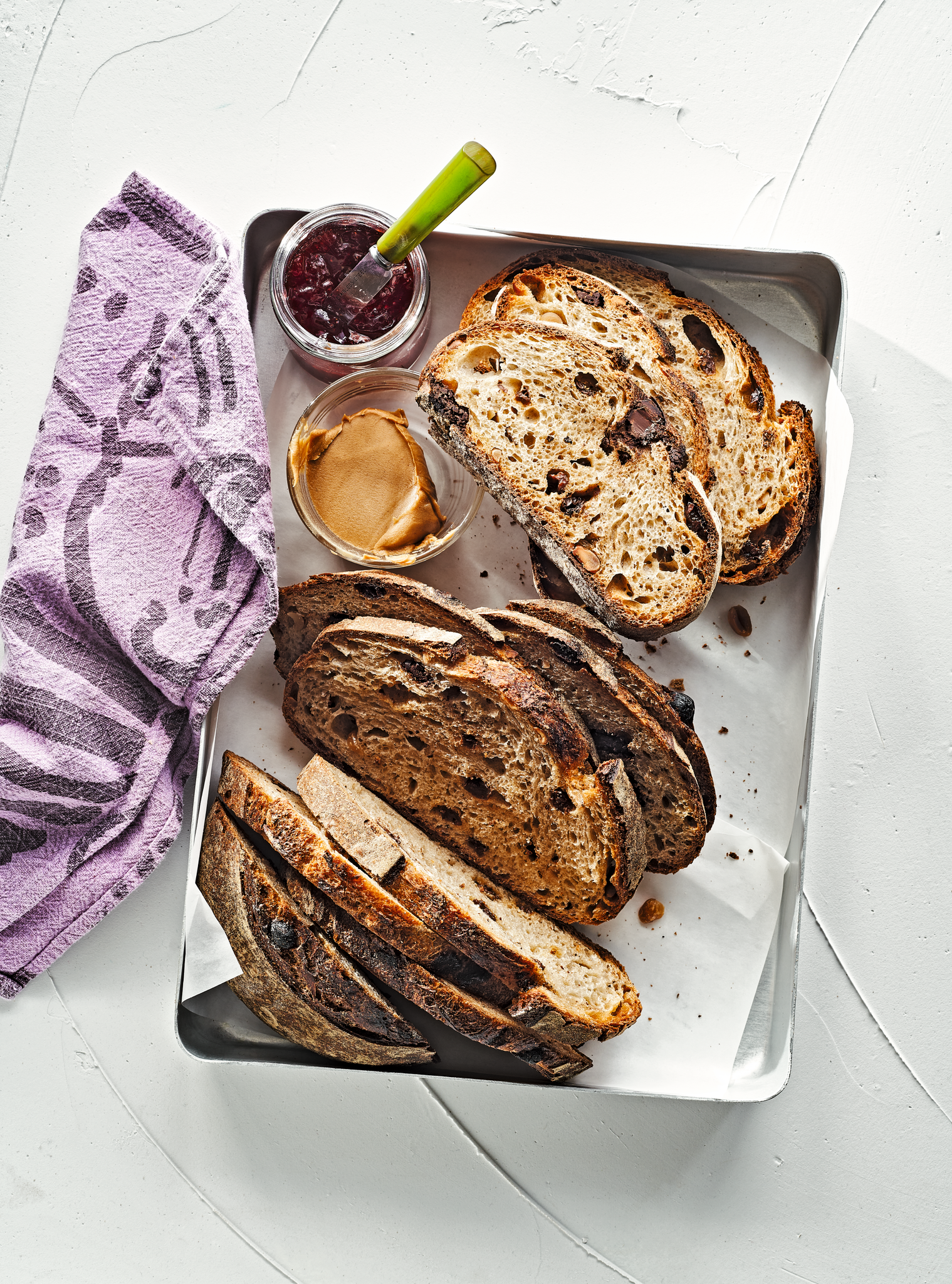Trail Mix Bread
Ingredients
WEIGHT & INGREDIENTS
News with a little more humanity
WPR’s “Wisconsin Today” newsletter keeps you connected to the state you love without feeling overwhelmed. No paywall. No agenda. No corporate filter.
SOAKER
- 35g raisins, red
- 35g warm water
DOUGH
- 317g bread flour
- 35g whole wheat flour
- 247g water
- 88g sourdough starter
- 44g peanut butter, smooth
- 44g semisweet chocolate
- 35g roasted peanuts
- 35g raisins, soaked
- 7g salt
Instructions
THE NIGHT BEFORE: SOURDOUGH STARTER REFRESH, SOAK RAISINS, PREP CHOCOLATE AND PEANUTS
Following the instructions on page 67, refresh your sourdough starter the night before or up to 10 hours prior to mixing the dough.
Soak the raisins In a pint-size deli container (or similar container), weigh out the raisins and add the warm water. Cover with a lid and soak overnight or until needed.
Prep the chocolate and peanuts Roughly chop the chocolate and roasted peanuts into pea-size pieces. Transfer them (they can be stored together) to a quart-size deli container (or similar container), cover with a lid, and set aside.
DAY ONE: MIXING, FOLDING, SHAPING, PROOFING, AND CHILLING
First mix In a large bowl, thoroughly mix together the bread flour, whole wheat flour, and water by hand until there are no patches of dry flour. You can squeeze the dough through your hands, like extruding pasta between your fingers! The dough will be sticky, gluey, and shaggy.Pop a digital thermometer into the dough to take its temperature—it should be between 75° and 81°F. (If the dough is above 81°F, stick it in a cool spot—not the refrigerator—until it cools to between 75° and 78°F. If it is cooler than 75°F, place it in a warm location until it reaches between 75° and 78°F.)
Autolyse Cover the bowl with a dinner plate or sheet pan for a lid and let rest for 1 hour.Final mix and additions Drain the raisins and pinch them into the dough along with the chopped chocolate, peanuts, peanut butter, starter, and salt. The dough will become stringy and fall apart; that’s normal, just keep mixing until it re-forms into a cohesive mass. Cover and set aside to rest for 30 minutes.
Fold Once the dough is relaxed, you will give it a series of three folds spaced 1 hour apart. To fold, smear a little water onto your work surface.
Using a dough scraper, gather the dough together and, with a quick motion, scoop the dough up with the dough scraper and flip it onto the wet table. Using your hands, lift the dough off the table, then slap the bottom half down, so that it sticks a little. Gently leaning back, stretch the dough and then quickly lean forward, tossing the dough still in your hands over the portion stuck to the table. Repeat three to four times. The dough will become smooth and pull itself into a ball. Using the dough scraper, return the dough to its container, smooth-side up, cover with the plate or sheet pan, and let rest for 1 hour. Repeat the process two more times, with 1 hour between folding sessions.
Pre-shape Lightly dust your table with flour. Using a dough scraper, gather the dough together in the bowl and, with a quick motion, scoop the dough up with the dough scraper and flip it onto the table. Pat into a rectangle with a short side facing you. Fold the edge of the dough closest to you over to the top (the edge farthest from you), leaving a 1-inch lip. Take the sides of the dough, gently stretch each outward a few inches, then quickly cross them over each other so they are on top of each other, like swaddling a baby. Next, stretch the edge of the dough closest to you up to the top, flush with the top edge. Gently press down to create a seam and seal.
Use your hands or a bench knife to gently drag the loaf on the table to create surface tension. You will see it tighten and become smooth as you drag. Make sure the top stays the top and the dough doesn’t roll over as you go. The dough will curl into itself so the seam is now on the bottom and the top is smooth and roundish. Bench rest Sprinkle the dough with flour, cover with a kitchen towel, and let rest 30 minutes.
Final shape Lightly dust a cloth-lined 9-inch oval banneton with flour and set aside. Lightly dust your table with flour. Use a bench knife to flip over the pre-shape so the top is now the bottom. Bring the bottom of the dough to meet the top edge, leaving a 1-inch lip at the top. Gently stretch the sides outward a few inches, then quickly cross them over the middle of the dough, like swaddling a baby. Stretch the bottom of the dough up to meet the top of the envelope and seal. The dough will now be a cylinder on its side with a seam facing away from you. Roll the seam underneath and seal the left and right ends using the edge of your palm. Using a bench knife, transfer to the prepared banneton, seamside up.
Proof Loosely cover the banneton with a kitchen towel and proof the dough in a draft-free spot at room temperature for 2 to 3 hours. When fully proofed, the loaf will appear to have doubled in size, feel full of air, and pass the poke test (see page 55).
Chill When proofed, transfer the banneton, covered with a shower cap or kitchen towel, to the fridge for at least 6 hours and up to 24.
DAY TWO: BAKING
Preheat the oven Seta combo cooker on a rack in the oven so the skillet is the bottom and the pot is inverted as a lid. Preheat the oven (and the combo cooker) to 500°F.
Score Wearing welding gloves, remove the combo cooker from the oven (it’s hot!) and quickly toss the cold dough seam-side down onto the hot skillet portion of the cooker. Use a lame and razor, with the blade at a 35-degree angle, to score in one long stroke, running lengthwise along the top of the bread.
Bake Immediately cover the bread with the inverted pot for a lid and load it back into the oven. Bake for 15 minutes. Remove the combo cooker from the oven and set on the stovetop. Remove the lid (be careful of hot steam) and reduce the oven temperature to 475°F. Return the bread, still on the skillet portion of the combo cooker, to the oven and bake another 15 to 20 minutes, or until the loaf is deeply browned, reaches an internal temperature of 190°F, and sounds hollow when tapped on the bottom. Carefully remove the bread from the skillet and cool on a wire rack for 1 hour. Store for up to 5 days, cut-side down, in a paper bag tucked inside a cloth bag.
From “Flour Power” by Tara Jensen.
Wisconsin Public Radio, © Copyright 2026, Board of Regents of the University of Wisconsin System and Wisconsin Educational Communications Board.




